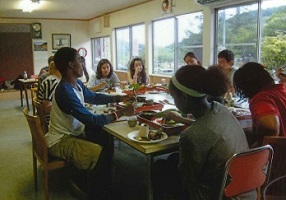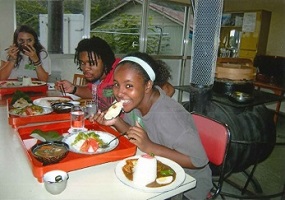PEOPLE
Owner at Tōge Chaya

“You won’t know unless you try.”
Ms. Ogasawara: Of course it’s only in hindsight that I can say that it was a good experience. In the course of dealing with the nitty-gritty aspects of business in the Women’s Association, I was involved in a variety of conflicts. I didn’t have any formal education and I was pretty naïve in the ways of the world, so I instinctively shied away from the idea that I could do anything significant. At the time, the director of the promotion center said to me, “You won’t gain any confidence by not doing anything, but since we’re calling on you because we believe you’re capable, I want you to suck it up and get to work. You won’t know unless you try, right?” I’ll never forget that. At the time, despite that pep talk, I still felt myself to be at a loss, to the point where I pleaded with people not to let the director know I was there when I visited the promotion center. It was only when I saw that the product that we had made ourselves prove to be a major hit that for the first time I felt that “even a housewife can succeed if she tries!” They say that people who tell you the brutal truth are like the gods, but it’s the truth, you know. Eventually, the idea of managing a restaurant came up at the Women’s Association, and some folks advised me at the time that if I were going to open a restaurant then it would be a good idea for me to get certified as a cook. I guess I wasn’t very confident about that idea, but then I remembered the director saying that “You won’t know unless you try,” and so I enrolled in classes at a cooking school in Kamaishi. My sons would say to me that “there’s no way a sixty-year old is going to pass the national examination,” but I figured I had nothing to lose, so I gave it a shot and passed on my first attempt. My family was astonished, as well, but I think that I might have surprised myself most of all.
Tōge karē, born out of connections with people
Ms. Ogasawara: The eatery we were running at the Women’s Association served light meals such as udon, soba, and ramen noodles made with locally harvested wild vegetables. As the association’s membership grew older, however, it became more difficult to keep the eatery running since the fact was that most of the younger people had left for the city. I thought that if that’s the way things were, then I’d like to start up a restaurant that my husband I could run ourselves, which is when I conceived of the idea of “Tōge Chaya.” When you get right down to it, I had worked hard to get my qualifications as a cook, and I wasn’t at a point in my life where I was ready to stop using them. However, when the Great East Japan Earthquake struck in March 2011, we all suddenly had other things to worry about. I was contacted by the proprietress of the Hōraikan Inn, who was connected with me through our Local Cuisine Study Group. She had been wondering about whether there might be something we could do for the folks affected by the disaster. She said that she had set up a temporary diner at the Hōraikan, but she wanted to give her staff a break and was wondering if I could lend a hand. So I said I could help out with some light cooking, and decided to put together a menu of curry and rice and okame soba (i.e., a dish made with buckwheat noodles in a soup with slices of boiled fish paste, shiitake mushrooms, greens, and seaweed, etc.) I’d go up there once a week and serve food at the temporary diner. These days my work at the temporary diner is finished, but there was one day that a fellow from the city office came to eat there. He ordered a plate of curry and complimented me on how delicious it was. He recommended that if I ever opened my own shop, I should make curry the feature dish. When I replied that I didn’t really feel confident enough at that point in time, he suggested to introduce me to a professional I could study with. The person he introduced me to is now the president of a nationally famous Japanese curry company. Even then, I went back to my bad habit and shied away from the idea, but I was inspired again by the idea that “you won’t know unless you try” and decided to take him up on his offer. Even so, it was tougher than I expected. I was told to bring in some of my own curry, which I did, and after the first bite he said, “What’s up with this curry?” He said my curry was fine for home cooking, but couldn’t be used for business. When I asked him what was wrong with it, he said that it had too many potatoes. He pointed out to me that some people dislike potatoes, so I should be aiming to make a curry that everyone would like. I felt kind of dejected at that, but then he asked me whether I was truly motivated. When I answered that I really was game, he said to me, “All right then, I’ll hook you up with one of my young people,” and held out his hand to me. That’s why my tōge curry, which is the product of the training I got at that company, is more than just any curry. It’s a specialty that was born out of connections with people who cared. And that curry creates new connections with people who come to see the Hashino Iron Mine. Could there be anything more wonderful?
(Photos) American high school students from NY who visited for an on-site learning - they made thin wheat noodles and dumpling for lunch / they had curry set with edible wild plants for dinner




Representative Director, National Congress of Industrial Heritage
(Honorary Advisor, Kyushu Railway Company (JR Kyushu)
Senior Researcher, Industrial Heritage Information Centre
Honorary Advisor, Nippon Mining Co., Ltd.
The Ambassador of Supporting Kamaishi Hometown
Former Director of Nagasaki City World Heritage Office
Former General Manager, Nagasaki Shipyard and Machinery Works, Mitsubishi Heavy Industries, Ltd.
Chairman, Fujisankei Group
Executive Managing Advisor, Fuji Television Network, Inc.
Executive Managing Advisor, Fuji Media Holdings, Inc.
Advisor, Federation of Japan Port and Airport Construction Association
(Ex. Chairman of Specialists Center of Port and Airport Engineering)
Mayor of Nagasaki City
Former Director of the Sano Tsunetami Memorial Museum (currently known as Sano Tsunetami and the Mietsu Naval Dock History Museum)
Director of NPO Association for Thinking about Satoyama
Director of National Congress of the Industrial Heritage
Honorary Chief Priest Toshinari Ueda
Former Mayor of Omuta City
Archaeologist and Heritage Conservation Specialist
A fellow of the Japan Federation of Engineering Societies
Team Member of the Industrial Project Team Office for the Promotion of World Heritage Listing under Cabinet Secretariat
Governor of Kagoshima Prefecture
Mayor of Hagi City
Mayor of Uki City, Kumamoto Prefecture
The Former Employee of Nippon Steel Corporation
An Associate Professor of the Faculty of Science and Engineering in Iwate University
Chairman of the Tourist Guide Association of Misumi West Port
President of Kuraya Narusawa Co., Ltd.
Chairman of Izunokuni City Tourism Association
Director and General Manager of Gunkanjima Concierge
Producer of the Gunkanjima Digital Museum
Owner at Tōge Chaya
Chairman: Mr. Hidenori Date
President: Mr. Masahiro Date
Proprietor, Houraikan Inn
Representative Director of Egawa Bunko non-profit incorporated foundation
The 42nd head of the Egawa Family
Democratic Party for the People (DPP) Representative for Nagasaki Prefecture
President of the NPO, Way to World Heritage Gunkanjima
Representative Director
MI Consulting Group
President of Watanabe Production Group and Honorary Chair of Watanabe Productions Co., Ltd.
Member of the House of Councillors
Governor
Kagoshima Prefecture
World Heritage Consultant
Director and Dean, The Kyushu-Asia Institute of Leadership
Representative Director, SUMIDA, Inc.
Journalist, founder of the Shimomura Mitsuko Ikikata Juku School
Representative, Rally Nippon
Chairman, Sites of Japan’s Meiji Industrial Revolution World Heritage Route Promotion Council Director, National Congress of Industrial Heritage
Representative Director, General Incorporated Foundation National Congress of Industrial Heritage (Advisor, Public Interest Incorporated Foundation Capital Markets Research Institute)
Mayor of Nagasaki City
Policy Director at Heritage Montreal
World Heritage Consultant
Executive Director of Kogakuin University
Heritage Architect and International Consultant
Head of Data Acquisition at The Glasgow School of Art’s School of Simulation and Visualisation
Head of Industrial Heritage, Historic Environment Scotland, Edinburgh
Scottish Ten Project Manager, Historic Environment Scotland, Edinburgh
Mayor of Izunokuni City, Shizuoka Prefecture
Pro-Provost and Chairman of Council of the Royal College of Art. Heritage advisor of Canal & River Trust for England and Wales.
Dean of Tokyo Rissho Junior College
Professor emeritus of Keio University
Mayor of Kitakyushu City
At the 39th session of the World Heritage Committee convened in Bonn, Germany, from June 28 to July 8, 2015, the decision was approved to inscribe the Sites of Japan’s Meiji Industrial Revolution on the World Heritage list.
At a celebratory party held to mark the occasion, some of the primary promoters of the project spoke of their joy in achieving their goal and of the trials and tribulations to getting there.
Director and Managing Executive Officer, Hanshin Expressway Company Limited
Member, Board of Directors, National Congress of Industrial Heritage
Vice-Governor of Shizuoka Prefecture
Mayor of Hagi City
Chairman, Tokyo Metro Co., Ltd.
Mayor of Omuta City
Deputy Director-General, Lifelong Learning Policy Bureau, MEXT
Former Counsellor, Cabinet Secretariat
Mayor of Kamaishi City
Member, Board of Directors, National Congress of Industrial Heritage Counselor, Shimadzu Limited
Chairman of the Consortium for the World Heritage Inscription of Modern Industrial Heritage (Kyushu-Yamaguchi) and governor of Kagoshima Prefecture (as of 2015)